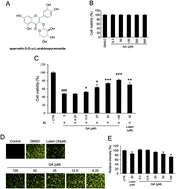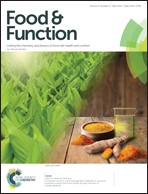Quercetin-3-O-α-l-arabinopyranoside protects against retinal cell death via blue light-induced damage in human RPE cells and Balb-c mice
Abstract
Age-related macular degeneration (AMD) is among the increasing number of diseases causing irreversible blindness in the elderly. Dry AMD is characterized by the accumulation of lipofuscin in retinal pigment epithelium (RPE) cells. N-Retinylidene-N-retinylethanolamine (A2E), a component of lipofuscin, is oxidized to oxo-A2E under blue light illumination, leading to retinal cell death. The aim of this study was to investigate the protective effect and mechanism of quercetin-3-O-α-L-arabinopyranoside (QA) against blue light (BL)-induced damage in both RPE cells and mice models. Treatment by QA inhibited A2E uptake in RPE cells, as determined by a decrease in fluorescence intensity. QA also protected A2E-laden RPE cells against BL-induced apoptosis. QA inhibited C3 complement activation and poly (ADP-ribose) polymerase (PARP) cleavage, as determined by western blotting. QA showed an inhibitory effect on AP1 and NF-kB activity as estimated in a reporter gene assay. In addition, QA activated the gene expression of aryl hydrocarbon receptor target genes (CYP1A1, CYP1B1) in TCDD-treated RPE cells. In the mice model, oral administration of QA protected against retinal degeneration induced by BL exposure as determined by histological analyses (thickness of retinal layers and immunostaining for caspase-3). In addition, QA inhibited apoptosis and inflammation via inhibition of NF-kB p65 translocation, C3 activation, and PARP cleavage. Collectively, these results revealed the protective mechanism of QA against BL-induced retinal damage both in vitro and in vivo.



 Please wait while we load your content...
Please wait while we load your content...